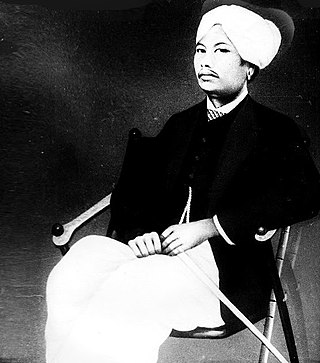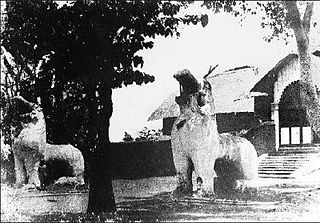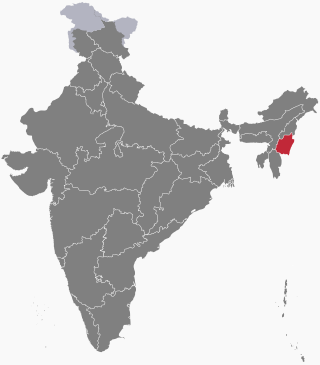Related Research Articles

Manipur is a state in northeast India, with the city of Imphal as its capital. It is bounded by the Indian states of Nagaland to the north, Mizoram to the south and Assam to the west. It also borders two regions of Myanmar, Sagaing Region to the east and Chin State to the south. The state covers an area of 22,327 km2 (8,621 sq mi). The official and most widely spoken language is the Meitei language. Native to the Meitei people, it is also used as a lingua franca by smaller communities, who speak a variety of other Tibeto-Burman languages. Manipur has been at the crossroads of Asian economic and cultural exchange for more than 2,500 years. This exchange connects the Indian subcontinent and Central Asia to Southeast Asia, East Asia, Siberia, regions in the Arctic, Micronesia and Polynesia enabling migration of people, cultures and religions.
Manipuri may refer to:

Ningthou Ching-Thang Khomba (1748–1799) was a Meitei monarch of the 18th century CE. He is known for having invented the Manipuri Raas Leela dance, with his daughter Shija Lailoibi playing the role of Radha at the first performance and is a popular figure in Manipur. He is also credited with spreading Vaishnavism in Manipur State after his grandfather Pamheiba made Hinduism the official religion and for creating a unified Manipur. Much of his history is mythologized.

Chinglen Nongdrenkhomba (1788–1834), also known as Raja Gambhir Singh, was a ruler of the Manipur Kingdom.
Debindro Singh or Devendra Singh or Devendrajit Singh or Debendra Singh was a Manipuri King who ruled in 1850 for a period of only three months at the age of forty-seven. He ended the custom of paying bribes to chiefs to gain land in Manipur. He was the successor to, and brother of Nara Singh, the regent of Gambhir Singh. He was given the title of Raja by the British, but he was unpopular. After only three months Chandrakirti Singh invaded Manipur while Devendra Singh fled to Cachar.
Madu Chandra was a Meitei royal who ruled between 1801 and 1806. He fought for power during the dynastic squabbles in Manipur after the death of Bhagyachandra.

Chourjit Singh, also known as Charajit Singh, was a Meitei King and a Maharaja of Kangleipak, who ruled between 1806 and 1812.

Marjit Singh was a Meitei king who ruled Manipur kingdom between 1812 and 1819 as a vassal of Burma, but was eventually expelled by the Burmese. The Burmese devastated Manipur during a seven-year occupation that came to be known as Chahi-Taret Khuntakpa.

Koirengba was a Meitei king in the early 16th century who ruled between 1507 and 1511.

Tikendrajit Singh, also known as Koireng, was a crown prince of Kangleipak in present-day northeastern India, which was a protectorate of British Raj at that time. Tikendrajit was the commander of the Manipuri army and engineered a palace revolution that led to the events known as the Anglo-Manipur War of 1891 or the Manipur Expedition.
The history of Manipur is reflected by archaeological research, mythology and written history. Historically, Manipur was an independent sovereign kingdom ruled by Meitei dynasty but at different point of time it was invaded and rule over by other state and authority. The Kangleipak State developed under King Loiyumba with its first written constitution in the early 12th century. Manipur under the 18th-century king Pamheiba saw the legendary burning of sacred scripture.

Surachandra Singh was a Meitei King and a Maharaja of Kangleipak, who ruled between 1886 and 1890. He became the Raja of Manipur in May, 1886 after his father Raja Chandrakirti Singh died.

Chandrakirti Singh was a Meitei monarch and the Maharaja of Manipur Kingdom. He was the son of Maharaja Gambhir Singh.

The Manipur Kingdom was an ancient kingdom at the India–Burma frontier. Historically, Manipur was an independent kingdom ruled by a Meitei dynasty. But it was also invaded and ruled over by Burmese kingdom at various point of time. It became a protectorate of the British East India Company from 1824, and a princely state of British Raj in 1891. It bordered Assam Province in the west and British Burma in the east, and in the 20th century covered an area of 22,327 square kilometres and contained 467 villages. The capital of the state was Imphal.

Maharaja Sir Churachand Singh, also known as Churachandra or Chura Chand (1886–1941), was a ruler of the princely state of Manipur under the British Raj. He ascended the throne after his predecessor Kulachandra Singh was jailed. He was a 5-year-old boy when he was placed on the throne on 22 September 1891, after the troubles of the Anglo-Manipur War of 1891. In 1907, he was formally declared king, after completing education at Mayo College.

Maharaja Bodhchandra Singh or Bodhachandra Singh (1908–1955) was the last ruler of the princely state of Manipur under the British Raj as well as the Dominion of India. He ruled between 1941 and 15 October 1949. During his term, India was decolonised by the British, receiving independence on 14 August 1947. The Maharaja presided over a transition to democracy, passing the Manipur State Constitution Act 1947. He signed the Instrument of Accession, joining India shortly before the British departure. In 1949, a few months before India became a republic, he signed a merger agreement, whereby Manipur became an integral part of India governed by the Constitution of India.

The Anglo-Manipur War or Manipuri Rebellion of 1891 was a short armed conflict between the British Colonial Forces and the dissenting royal princes of Manipur Kingdom, which was arguably a dependency of the British Empire in India. The conflict began with a palace coup staged by the general (Senapati) of Manipur, ousting its reigning king, and installing a half-brother in his place. The British government took objection to the action and attempted to arrest the general. The effort failed, with the Manipuri forces attacking the British residency and the resident and other British officials getting executed. The British launched a punitive expedition that lasted from 31 March to 27 April 1891. The general and other rebels were arrested and convicted. The British annexed Manipur and governed it as a princely state till 1947.
Ningthoukhongjam Khelchandra Singh was an Indian writer, lexicographer and historian, known as the author of Manipuri to Manipuri and English, the first modern general dictionary in Meitei language, which was published in 1964. He was a fellow of the Sahitya Akademi and Sangeet Natak Akademi. The Government of India awarded him the fourth highest civilian honour of Padma Shri in 1987.

The following outline is provided as an overview of and topical guide to Manipur:
Maharaja Ishan Chandra Manikya of the Manikya Dynasty was the king of Tripura from 1849 to 1862